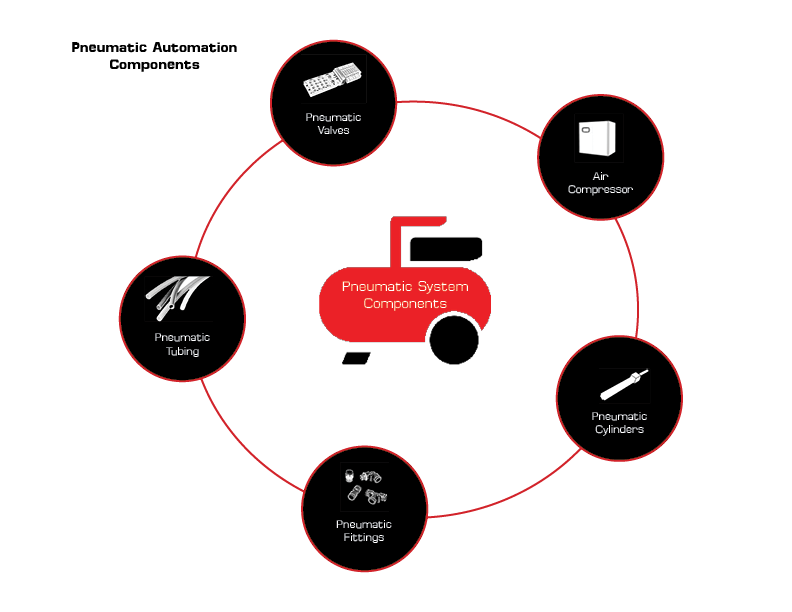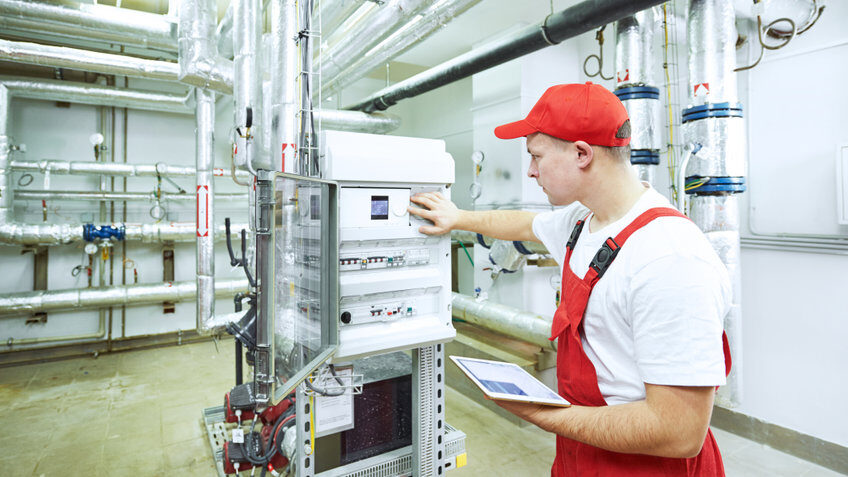Regular Maintenance Ensures Functional and Efficient Pneumatic Systems

While pneumatic systems are often selected because they have a reputation for providing high reliability in tough industrial applications, that doesn’t mean that they don’t require a little TLC now and then. As a matter of fact, creating and adhering to a schedule of regular inspection and maintenance activities will ensure that your pneumatic systems continue to function with few problems and high levels of safety.
About Pneumatic Systems
In automated industrial systems, pneumatics are often used for process and machine control. They employ a system of air-driven cylinders, actuators and valves. Subunits of pneumatic systems include an air treatment system consisting of an air intake filter, compressor, cooler, separator, dryer, line filters, drains, receiver tank and pressure control valve. Based on a complex interaction that takes place between the compressed air and the functional parts of the system, pneumatic systems are used to operate a myriad of equipment, including material handling, sorting, and packaging machinery. Smaller-scale pneumatic systems may control the grippers on robots or the valves in refinery equipment, among other applications. While their operation is basic, they are often used on critical production equipment, so any issues should be addressed before failure occurs. The best way to avoid failure and the associated downtime and production losses is through regular inspections and maintenance.

Reasons to Up Your Pneumatic Maintenance Game
Ignoring preventive maintenance is likely to result in a pneumatic system that suffers leaks, component wear and tear, increased operating temperatures and contamination issues that can lead to losses in efficiency and function and, ultimately, system failure. There are other less obvious benefits to performing routine maintenance as well, including:
- Assurance of Safety: Regularly performing preventive maintenance tasks on pneumatic systems ensure that the machinery is operating in a safe state with little chance of harming operators or nearby employees.
- Efficient Performance: Inspecting the components in a pneumatic system for wear and tear and regularly lubricating machine parts will help ensure operational efficiency, as friction creates worn components, which leads to drastic reductions in performance and consequent failure.
- Labor Reductions: While it does take time to inspect and perform preventive maintenance tasks, the time to do this is significantly less than the time and expense required to repair mechanical failure. In addition, when these tasks are scheduled, it does not interfere with production as would occur with unscheduled maintenance that results from neglect.
- Extended Lifetime of System Components: Carrying out regular maintenance ensures longer life of the pneumatic system components, which are costly to purchase when replacement is required due to failure. Often, adhering to the manufacturer’s suggested preventive maintenance schedule will keep the warranty valid, as well.
Maintenance Tasks That Should Not Be Neglected
Because pneumatic systems are highly reliable, it is easy to put off routine maintenance, but, as discussed earlier, doing so can result in loss of function and expensive downtime and repairs. To keep pneumatic-powered equipment up and running, there are a few maintenance activities that should be high priorities, including detecting and repairing leaks, confirming that the system is properly lubricated, checking and changing filters and maintaining a cleaning schedule.
- Find and fix leaks: If leaks are neglected for too long, issues such as pressure drops, increased system load and compressed air waste will occur, resulting in loss of function, efficiency and rising operational costs. Typically leaks within a pneumatic system can be heard, making them easy to find. A soapy water solution may also be sprayed onto areas of suspected leakage (the solution will produce bubbles if there is a leak). Since seals, gaskets, fittings and joints are the most common sites for system leakage, make a point to check them on a regular basis. If leaks are detected, loose components should be tightened and adhesive may be used to quickly seal leaks. Any damaged parts should be replaced promptly to avoid failure or safety issues with the equipment.
- Confirm proper FRL operation: One of the most crucial components of a pneumatic system is the FRL (filter regulator lubricator) system as it keeps dirt, dust and other contaminants out of the system and ensures that the system is adequately lubricated, preventing friction and component wear and tear. It also assures the machine is operating at its correct pressure setting and the inspection makes certain that the FRL system is in good working order, confirming that the pneumatic system will continue to operate without issue or flagging areas of concern so they may be repaired before the system fails. Keep in mind that if used the oil level in the lubricator will also need to be checked regularly and replenished as needed.
- Check and change filters: Because pneumatic systems rely on air to operate, filters play an important role in keeping dust, dirt, vapors and oils out of the system. However, these contaminants will eventually build up and clog the filter, leading to pressure drops and forcing the system to work harder. Filters should be inspected on a regular basis and cleaned or replaced when needed to keep the system running efficiently.
- Adhere to a cleaning schedule: Cleaning should be a part of your daily maintenance routine as dust, dirt and other contaminants present in the air and the operating environment can accumulate on the equipment and enter the pneumatic system. Be sure to wipe down the exterior of the actuators and cylinders using soft cloths on a regular basis to gently remove dirt before it becomes layered and caked on. Regular cleaning is essential in industries such as food processing, pharmaceuticals, electronics, and those that produce sensitive products to avoid contamination.
- Control valves: Proper control valve operation is critical to maintain machine performance & safety. Regular inspections for leakage through the valve body, gaskets or exhaust ports and confirming proper performance of the actuators operated by the valves is a good idea.

While the above-mentioned tasks should be performed on a regular basis, there are additional maintenance projects that should not be overlooked. Be sure to adhere to the schedule provided by the manufacturer when planning these activities.
While pneumatic systems provide high levels of reliability, they will not function optimally without periodic attention. Adhering to a schedule of maintenance activities will help your pneumatically operated machinery perform well for years to come, ensuring production capacity and reducing the costs associated with downtime and repair.
For more information on maintaining your pneumatic system, please reach out to an expert at JHFOSTER.